Abstract
The uniqueness of Psychiatry as a medical speciality lies in the fact that aside from tackling what it considers as illnesses, it has perchance to comment on and tackle many issues of social relevance as well. Whether this is advisable or not is another matter; but such a process is inevitable due to the inherent nature of the branch and the problems it deals with. Moreover this is at the root of the polarization of psychiatry into opposing psychosocial and biological schools. This gets reflected in their visualization of scope, in definitions and in methodology as well. Whilst healthy criticism of one against the other school is necessary, there should be caution against hasty application of one's frame of reference to an approach that does not intend to follow, or conform to, one's methodology. This should be done within the referential framework of the school critically evaluated, with due consideration for its methods and concepts. Similarly, as at present, there is no evidence to prove one or the other of these approaches as better, aside from personal choice. We can say so even if there is a strong paradigm shift towards the biological at present. A renaissance of scientific psychoanalysis coupled with a perceptive neurobiology which can translate those insights into testable hypotheses holds the greatest promise for psychiatry in the future. This suggests the need for unification of diverse appearing approaches to get a more comprehensive and enlightened worldview. It requires a highly integrative capacity. Just as a physicist thinks simultaneously in terms of particles and waves, a psychiatrist must think of motives, emotions and desires in the same breath as neurobiology, genetics and psychopharmacology. However, the integration must be attempted without destroying the internal cohesiveness of the individual schools. This will give a fair chance for polarization in which a single proper approach in psychiatry could emerge, which may be a conglomerate of diverse appearing approaches of today, or one which supersedes the rest. A synthesis of cognitive psychology and neuroscience offers the greatest promise at present.
Keywords: Resolution of differences, Integration of schools, Polarisation of approaches, Biological and psychosocial dichotomy, Psychoanalysis and Cognitive Neuroscience, Eclecticism in psychiatry
Introduction
It's exciting times in which we live. So much is changing all around, and yet so much needs to remain, and does remain, firmly rooted. Changes sweep the dust of indolence and laxity, besides of course sweeping off the desirable too at times. The decisive paradigm shift towards psychopharmacology and biological approaches to behaviour has alarmed a number of senior practitioners and senior researchers in Psychiatry. That psychiatrists are turning more psychopharmacologists and lesser psychotherapists is the reality of today. But that is no real cause for alarm. Because as long as they produce results and back up their opinions with evidence, they indeed need to prosper. The apprehension, of course, is that legitimate growth of psychotherapy may get sidelined, or the brighter minds may be averse to taking up psychotherapy because it is no longer the in-thing to do. But such a flux state is inevitable in the advancement of any branch. Ultimately, the psychotherapeutic approach itself will benefit by shedding its smug somnolence, become more evidence and experiment based, offer verifiable population statistics to back up its contentions, and compete with biological approaches with greater methodological rigour. This manthan, or flux, is inevitable, and indeed welcome, if we wish to chart new and exciting frontiers in the field of psychiatry in particular, and all social sciences in general. The discomfort of today is only a prelude to the comfort of tomorrow. Hopefully. For the seeds of comfort lie in every discomfort, as the seeds of discomfort lie in every comfort (Singh and Singh, 2004a).
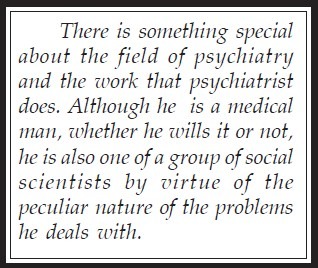
There is something unique about the field of psychiatry and the work that a psychiatrist does. Although he is a medical man, whether he wills it or not, he is also one of a group of social scientists by virtue of the peculiar nature of the problems he deals with. Thus, though he makes common cause with medicine on the one hand - considering, genetic, constitutional, biochemical and other physical influences - he has perchance to consider as well, sociological, cultural and cross-cultural, environmental, theological and mythical phenomena, and he utilises his psychological frame of reference to explain these. The uniqueness of psychiatry as a medical speciality derives from its concerted effort to integrate the psychosocial and biological in human health and disease (Gabbard, 1999). Similarly the IGDA 1994 project (IGDA means International Guidelines for Diagnostic Assessment, a collaborative effort between WHO and WPA) talks of assessment of the psychiatric patient as a whole person rather than just a carrier of diseases (IGDA, 2003a) :

This assumes in the clinician the exercise of scientific competence, humanistic concern and ethical aspirations. Another essential feature is the coverage of all key areas of information (biological, psychological and social) pertinent to describing the patients’ disorders, dysfunctions and problems, as well as their positive aspects or assets (IGDA, 2003a).
Some authorities would advise caution against such a diversification, their basic argument being that the psychiatrist deals with psychopathology, and hence should desist from applying his concepts of morbidity to human behaviour as a whole, something with which he has no special acquaintance (Slater and Roth, 1986). His day to day work is primarily with persons behaving in an abnormal or atleast unusual way, and this gives him a bias in perspective. Many psychiatrists have a burning impulse to theorise as if psychiatry were what philosophers and epistemologists call a ‘knowledge of salvation (Ibor, 1973). The psychiatrist's crystal ball is likely to be as clouded as anyone else's and his special training does not make him an instant expert on everything that goes on in this world (Chodoff, 1981).Psychiatrists may be particularly susceptible to this hubristic temptation because of the intense relationships which they develop with patients and because of the illusion of omnipotence, an occupational hazard (Chodoff, 1981).
However, since disordered behaviour touches upon many aspects of life in society, the psychiatrist is interested in knowledge obtained from the biological sciences (which contribute information on personality growth and pathology) and in scientific and humanitarian studies that contribute to the understanding of individuals with personality disturbances. These include Psychology, the Social Sciences, Law, Philosophy and Theology (Kolb and Brodie, 1982). Psychiatrists must have knowledge of normal developmental processes across the life cycle (physiological, psychological and social) and how these processes are manifested in behavior and mental functions. The psychiatrist must also be an expert in the identification and evaluation of the signs and symptoms of abnormal behaviour and mental processes and be able to classify them along the defined clinical syndromes that constitute the psychiatric nosology. To arrive at a meaningful clinical assessment, one must understand the aetiology and pathophysiology of the illness along with the contributions of the patient's individual environment and sociocultural experiences. (Tasman, Kay and Liberman, 2003pxvii). Psychiatrist must be knowledgeable about a wide range of treatment options that include both somatic and psychotherapeutic techniques… (and) the sociocultural context within which the patient lives is a central aspect of this treatment process (Tasman, Kay and Lieberman, 2003, pxvii).
There is a further dimension to this. The psychiatrist cannot also act as a neutral spectator to issues of social relevance wherein his specialized knowledge of psychological processes can help in furthering understanding. Of course, one has to guard against the application of half-baked and ill-founded concepts to anything and everything having any psychological influence - this pathetic overselling of psychiatry (Cancro, 1985) has happened in the past, to the dismay and chagrin of the profession as well as the public. The example of the widely varying and impressionistic psychiatric opinions on the fitness of Senator Goldwater for the U.S. Presidential elections in 1964 is a case in point (Brown 1975). Another instance popular in certain circles is to undertake ‘psychobiographies’ that dissect public figures in painful and embarrassing ways on the basis of little or no direct data (Chodoff, 1981), thus vulgarising the pursuit of psychohistory itself.
The Consequence - Polarization
There is an obvious incompatibility in the two above mentioned views. A dispassionate but concerned overview which takes into account both these approaches is needed to grasp the essence of this polarisation, and eventually arrive at a consensus. The one which is more robustly biological visualizes psychiatry as a branch of medicine dealing with mental illnesses which are, or will be found to be, neuropathological in nature. The other which is more psychosocial considers it a science of human behaviour or the study of interpersonal relationships : it is thus much broader in scope. Both groups seem to have polarized into more or less opposing organic and psychodynamic schools(Trethowan and Sims, 1983). Call it the biomedical and psychosocial schools if you wish (Luhrmann, 2000). This has given rise to a division between the “doctors” and the “psychotherapists” : ‘The inherent problem has been compounded by real differences within our ranks, by conflicts of direction and interest, and these differences are being accentuated by the rapidly changing times in which we live … It is disturbingly possible that these differences may harden into a schizm in our ranks between “doctors” and the “psychotherapists”(Chodoff, 1981). The division results in an alarming dilemma which would concern many who wish well by the branch : if the province of psychiatry were defined as exclusively psychosocial the speciality would be turned over to clinical psychologists; if is were confined to the realm of neuroscience, neurologists might as well assume it should fall within their purview (Gabbard, 1999). Which would account to proving right the prophesy of the death of psychiatry raised in certain quarters. As Fuller Torrey says, those patients now called psychiatric patients would be divided into two groups and reassigned. Those who truly have diseases of the brain would eventually be annexed by neurology and those who do not would be considered under the jurisdiction of education. With nobody left to call a patient, psychiatry would wither and die (Fuller Torrey,1978.) A shocking but illuminating argument nonetheless; easy to brush under the carpet, but we may not be intellectually honest if we do. A radical examination and a fitting answer to such doomsday prophesies would be to reenergize the different schools while arriving at a consensus which adds to the whole corpus of knowledge in psychiatry. How is this to happen is one of the major concerns of this paper.
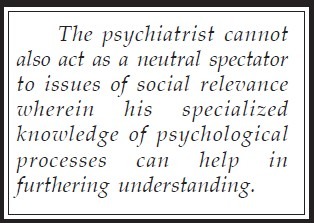
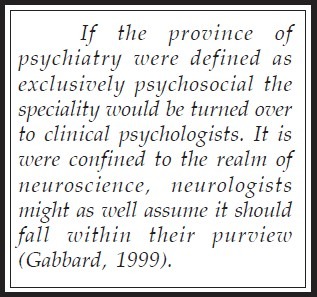
If this were not all, there is also the other schizm between those who are developing new knowledge in academic institutions, where the trend has swung decisively toward biophysical, neurophysiological and genetic models (Mechanic, 1984), and those relatively isolated from these but charged with the responsibility of dealing with patients on a day-to-day basis. In other words, between the researchers and the clinicians. This has led ‘to a profession that consists not of a united group of learned individuals who share certain core values and advocate certain positions in society, but rather of two quite disparate groups : one seeking to expand and advance knowledge, while holding an almost contemptuous attitude toward the adequacy of the scientific basis of contemporary practice; the other struggling to care for those who need their assistance, suspicious and mistrustful of the damage that might be done to their cause by idealistic scientists who are unfamiliar with the practical problems of applying scientific knowledge(Michels, 1981). Of course we may note that this state is not applicable only to psychiatry, but to medicine as a whole. Moreover, the juggernaut of managed care had intensified ideological tension between biomedical and psychosocial psychiatry (Luhrmann, 2000). These approaches are presented in different lectures, taught by different teachers, associated with different patients, and learnt in different settings. New policies have sharply enhanced that separation and sharply truncated the psychotherapeutic side (ibid). So that the biological appears to be on the ascendent today at the cost of the psychosocial. An interesting, though not alarming, state of affairs which will take its own time to resolve.
Schizm, Eclecticism and Rejection
Historically speaking, just as such a schizm has occurred with psychiatry as a branch, it also seems to occur with the individual psychiatrist and his development. Almost all pass through the conflict of accepting one or the other approach. Some try to be eclectic and are ready to accept whatever approach best clarifies matters. Eclecticism* seems to be increasing in the last few decades (Lazarus 1967, Woody 1971, Feather and Rhoads 1972,Thorne 1973, Simon 1974, Engel 1977, Trethowan and Sims 1983, Beutler1983, Patterson 1989, Singh and Singh, 1985, 2004a, Kandel 1998, 1999,Ghaemi 2003, Brendel 2003, Sadock and Sadock 2003) with a coming together of diverse viewpoints.
However, rarely can anyone be truly eclectic. Only one of the reasons for this is that to be considered an eclectic is still not very respectable in some quarters. Sooner or later, one of these approaches finds favour with most psychiatrists. This is understandable. But what almost always goes hand in hand with it is that the other view point is rejected. The two need not go together, but they often do. Some do so very early -they are fortunate, although liable to regret their decision later. Others do so over a long period of time, occasionally by the time they reach middle age when they look back and take stock of the efficacy of the methods and the discipline they have chosen for themselves, as they do about everything else at this period of life.
Depending on many factors, nor the least important being the personality characteristics of the concerned individual, this can lead to three undesirable results. One is disenchantment and drift away from the mainstream of psychiatry into peripherally related disciplines like literature, theology, philosophy, sociology, etc. The second is development of identity problems, boredom, resignation, undue pessimism, depression, hostility and the so called anti-psychiatric attitude. Boredom, particularly amongst psychotherapists (Altshul, 1977), with the development of a parapsychotherapeutic drift has been written about (Kubie,1971), the psychotherapist, as always, being more perceptive to the problem.
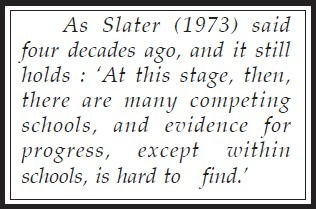
The third and equally damaging development can be rejection of contrary viewpoints reflecting either an inability or a disinclination. This rejection may be more covert than obvious, manifesting in subtle forms of neglect. It may manifest, for example, in smaller coverage to the less favoured approach, alloting lower priority, making only casual reference to its viewpoint, or refusing to adopt its procedures in therapy or research. This although they are of proven value and a corresponding effective procedure in one's approach of choice is nonexistent.
The rejection may be overt at times, when it manifests as aggressive criticism of viewpoints contrary to one's own. A condescending manner in speech or writing while referring to the less favoured branch is another manifestation of the same. Another still is the rise of militant and fanatical exponents of one or the other group, zealous reformers emotionally committed and in a hurry to do good. These are blind followers of a favoured approach to the total disregard of other contemporary ones (Carstairs, 1977).Although very critical of others, they cannot, like most critics, tolerate criticism of their chosen creed, and lay claim that generous intention automatically begets good results. Unfortunately, this has proved to be a false assumption (Carstairs, 1977). They are unable to empathise with or appreciate any point of view which fails to fit into their own frame of reference. Many observer shave noted that these subdivisions are especially prominent in American Psychiatry (Havens 1973, Klerman 1982). So intense are the loyalties and emotions manifest in the adherents of these various schools that psychiatry sometimes seems like an arena for conflicting ideological sects rather than a scientific discipline based on commonly shared methodological approaches and advances in empirical knowledge (Klerman, 1982). As Slater (1973) said, four decades ago, and it still holds : ‘At this stage, then, there are many competing schools, and evidence for progress, except within schools, is hard to find.’
Resolution, Phase one : Realization
The contention to be made here is that the psychiatrist has to be realistic. Whilst he cannot restrict himself from looking beyond the mental patient, he must prevent the temptation to facile psychologizing. Secondly, the very nature of his speciality uniquely suits him to tackle, psychologically and scientifically, the various psychological issues of social relevance. This may become a temptation, and a trap, for some; but it is a potential as well. And although Engel (1982) proposed the biopsychosocial model as appropriate for all of medicine, this vision has been achieved primarily in psychiatry (Gabbard, 1999). Moreover a fear of misuse should not preclude realization of the parameters of proper use. These psychosocial issues may be of medical interest, or otherwise. Some examples of social issues of medical interest are: the psychosocial complications of abortion and contraception; genetic counselling and eugenics in mental handicap and schizophrenia; social processes and pressures in alcoholism, drug addiction and sociopathy; pathology in the family (as a social institution) contributing to the battered-child and child psychopathology in general; the influence of socioeconomic factors in suicide; violent and other crimes committed by the sociopath, the early schizophrenic, and the paranoid patient; use of psychological processes to bring about forced social conformity (as seen in brainwashing and psychiatric labelling of political enemies); thanatology etc. And ofcourse defining what is mental health as different from the absence of mental illness, a positive and challenging way of looking at health and sickness which is obviously determined by social forces, a concern reiterated recently (Vaillant, 2003). As also publications like the Mens Sana Monographs (Singh and Singh, 2004a) which makes it their mission to give indepth understanding of psychiatric/psychological/philosophical consequences of social disorders/issues and current events.
The IGDA (2003b), while discussing its conceptual basis, emphasizes the nomothetic - idiographic integration an essential, and makes the following observation:
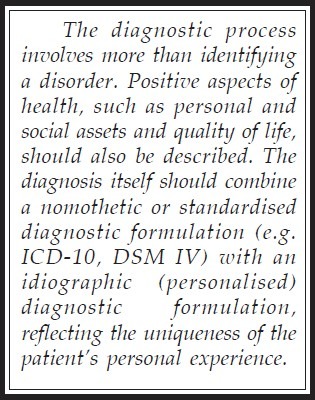
The diagnostic process involves more than identifying a disorder. Positive aspects of health, such as personal and social assets and quality of life, should also be described. The diagnosis itself should combine a nomothetic or standardised diagnostic formulation (e.g. ICD-10, DSM IV) with an idiographic (personalised) diagnostic formulation, reflecting the uniqueness of the patient's personal experience. At the nomothetic level, a multi-axial diagnostic formulation is recommended. For the idiographic formulation an integration of the perspectives of the clinician, patient and family should be presented in natural language (IGDA, 2003b).
In other words, the standardised must gel with the personalised and the socialised to make for good psychiatric practice. It is a moot point whether a nomothetic-idiographic orientation is valid only for psychiatry, or for all of medicine.
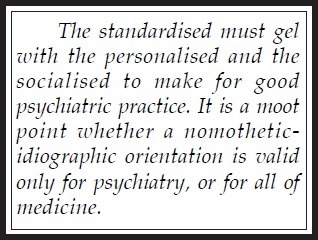
The issues on which psychiatrists comment can also be otherwise. Psychological aspects of issues of social relevance are an important area of discourse and are what we mean here. Issues like politics, creativity, religion, women's liberation, extramarital relations, incest, divorce/ separation, immigration, custody of the child, psychohistory etc., are, by no stretch of imagination, medical in the disease -label sense. Yet psychiatrists have to comment on and deal with these topics, in theory as well as practice. This part of his activity is uniquely his, it sets him apart from the rest of the medical profession. This can be called the pure social relevance of psychiatry.*
Let us enumerate a few examples here. Slow but steady progress seems to be made in the application of psychiatry to allied fields. Examples are the nomination of psychiatrists to Boards of Examination (not merely medical), inclusion of psychiatrists in political and administrative committees in bodies like the WHO whose emphasis is now also on mental health; information of committees like the Committee on Challenges for Modern Society(CCMS) at a multinational level; United States -Soviet Union bilateral agreement (1972) for research cooperation in areas of pressing medical interest - cancer, heart diseases, environmental health and psychiatry; Soviet-American joint effort in the control of drug abuse in Brazil etc. Foreign relations committees and government commissions in the U.S. have discussed psychological issues and included psychiatrists in them (Brown, 1975). Some authorities have urged psychiatrists to be more involved in welfare legislation, in matters of morality and values, in problems of personnel section, placement and promotion (Caplan 1964, 1965). And talking of personnel selection, psychiatrists are called on in the U.S. to make decisions about who is mentally healthy enough for certain positions- such as air traffic controllers and submariners (Vaillant, 2003).
There were some who earlier advocated that the psychiatrist must truly be a political personage in the best sense of the word. He must play a role in controlling the environment which man had created (Duhl, 1963). Caplan (1964) even went so far as to say that a psychiatrist might ‘exercise surveillance over key people in the community and … intervene in those cases where he identifies disturbed relationships in order to offer treatment or recommend dismissal’. Seen more than four decades later, we realize the futility of being swept in a visionary revolution which now appears as quixotic as invidious. None need however dispute the honest intentions: it was in their propagation that such messianism led to difficulties. In other words, the limits of involvement must not be transgressed, and the halo of omnipotence must be discarded. Such zealousness was also manifest with regard to preventive psychiatry and the community mental health movement, both noble and well- intentioned forays by genuinely concerned agencies which landed into numerous difficulties during implementation. Part of the failure of preventive psychiatry (Mechanic, 1984) and of deinstitutionalization and the community mental health movement which has been of concern to many (Scherl and Macht 1979, Talbot 1979, 1984,1985; Group for the Advancement of Psychiatry 1983, Singh and Singh2004b) must be traced to the immaturity of timing, lack of infrastructural blue-printing and the common failing in most idealists that good intentions automatically beget good results. For example, it was not the sociological thrust of the Community Mental Health Movement that was at fault; it was its implementation that went awry and for which a host of factors must share the blame. Perhaps there was truth in Talbot's thesis (1985) that this seemingly good idea miscarried because a strong scientific evidential had not been first laid (Group for the Advancement of Psychiatry 1983), the local community's participation had not been spelt out clearly (Talbot, 1979), governmental and other agencies did not clearly know or attempt to undertake what was expected of them (Scherl and Macht, 1979), and finally there was no plan to implement this change in the way 75% of psychiatric services were delivered (Talbot, 1979).
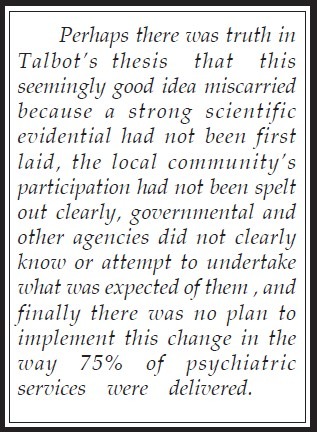
Different Orientation - Different Approach
Thus one can summarise the position as one wherein whilst psychiatry is a branch of medicine on the one hand, it is legitimately also a social science on the other. This explanatory dichotomy of psychiatric orientation makes one understand the diverse value systems of differently oriented psychiatrists and their schools of thought. It also becomes easier to understand why in psychiatry different definitions are worded the way they are, why emphasis is laid on diverse aspects of functioning and why certain definitions, hypotheses and theories are unacceptable in certain quarters. It also explains why schools of conflicting ideologies in psychiatry continue to remain at loggerheads rather than achieve a consensus.
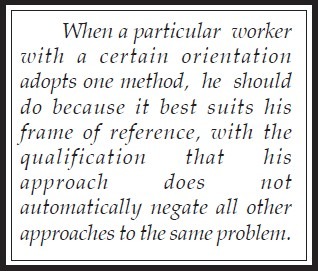
With this perspective in mind, we can understand why definitions are differently worded : they reflect the scope as envisaged by the investigator concerned. They are, and should be considered, at best, operational. And there is nothing undesirable about it, because the definition of terms should be operational and capable of clinical application. (Fifth WHO Seminar, 1969). And the clearer the definition the better (Sartorius, 1993, WHO 1989). Moreover, diagnoses themselves are like ready-made suits that come in a variety of standard styles and sizes. They fit many patients well, others adequately and same barely at all (Fauman, 1996, talking of DSM-IV diagnosis). It may not be improper to say that there is nothing sacrosanct about definitions or diagnosis except their operational utility.
When a particular worker with a certain orientation adopts one method, he should do because it best suits his frame of reference, with the qualification that his approach does not automatically negate all other approaches to the same problem. Similarly, he should desist from applying indiscriminately his criteria of selection, diagnosis, evaluation etc. to a work which does not intend to follow his methodology.
Thus, it is improper for the learning theorist to grill the biological psychiatrist to explain his biophysiological or biochemical theories in terms of learning principles, or try to so understand them himself; or reject them if they cannot be so explained. Similarly, it is inadvisable for the experimentally oriented to reject psychoanalytic findings on the basis that they are not double-blind, randomized, statistically correlated or correlateable. A danger lies in the quest for semantic and conceptual precision in clinical situations inherently characterised by biologic imprecision (Hudson, 1978), though that need not obviate the search for more scientifically and empirically definable criteria even in fields like psychoanalysis (Kandel 1983, Cooper1985). It is tragic but common for the biological psychiatrist or the psychoanalyst to poorly value the work of the social or community psychiatrist saying that their concepts are woolly or vague; and vice versa on the basis that they are too restricted, mechanistic and outdated. Just because we do not have the means to prove it does not mean it is not occuring. And just because it is occuring does not mean we necessarily have the means to prove it. ‘The same range of phenomena, though perhaps not the same particular phenomena, are seen, from … different points of view, in a very different way (Slater, 1973). What may not be realized by both sides is that though they work on psychological phenomena, their frames of reference are different, their approach and terminology are essentially applicable to their own field and cannot be hastily extrapolated from one to the other. Extrapolation may of course be possible over a period of time, as nuances of the processes are intimately scrutinized and honestly explored. But haste is the culprit, as perhaps is tenuous comparison. And, unfortunately, there is no Rosetta stone here to translate one paradigm of one school to another of another. Thus, criticizing one on sound scientific principles from the point of view of methodology, design, aim, etc., is legitimate. But rejecting the whole basis of one discipline because of one's dogmatic adherence to another is highly objectionable. This is commonly done, seldom realized, and frequently becomes the bone of contention in debates and seminars where psychiatrists of different orientation assemble. For ‘we must integrate all the disparate elements amongst us and stop backbiting, polarizing, and putting others down because of ideological self-righteousness or feelings of deprivation’ (Talbot, 1985).
Moreover, ‘psychiatry must be ever vigilant to avoid the perils of reductionism. In the 1950s and 1960s, the psychiatric enterprise tended to be construed as narrowly psychoanalytic. In the 1990s (and the present decade) with the extraordinary advances in neuroscience research the speciality is at risk of being reductionist in a biological direction. Subjective experience, interpersonal processes, and self-awareness are aspects of psychiatric study that must not be over looked in the excitement about neurotransmitters and molecular genetics’ (Gabbard, 1999,parenthesis added). And even if evidence based decision models are espoused with ample justification all around, including by us (Singh and Singh 2004b), the caution of Saunders is worth noting:
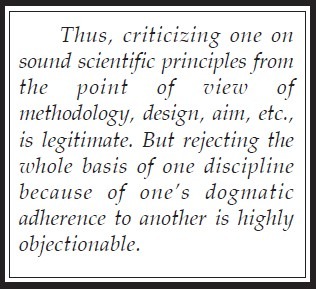
Evidence-based decision models may be very powerful, but are like computer-generated symphonies in the style of Mozart - correct but lifeless. The art of caring for patients, then, should flourish… in the recognition that what is black and white in the abstract often becomes grey in practice (Saunders, 2000).
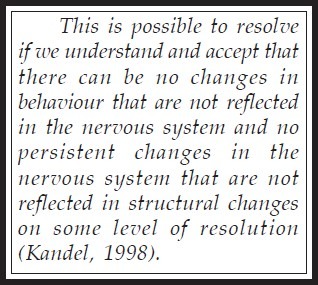
Hence, the quest for evidence should not reduce the passion for care.
Beveridge's warning about applying the reductionist model in clinical practice is worth more than a cursory glance here:
… the objective approach remains dominant in clinical practice and is inculcated in medical school and beyond. The patient is viewed as an object - a faulty biological mechanism that requires the detached gaze of the clinician to determine where the facts lie. The objective approach values hard data and is concerned with measurements, whether it is of blood, urine, cerebrospinal fluid or brain density. If it cannot be measured it is not considered important. Such a reductive model undoubtedly has its value, for example in simplifying complex clinical data. Problems arise, however, if the doctor is unable to see the patient as anything more than an object; if he or she loses sight of the patient as a human being (Beveridge, 2002).
Hence the reductionist approach should not mean reduction in care and empathy which are the hallmarks of good clinical practice.
Resolution, Phase Two : Integration
Talbot (1985) lamented that ‘we have failed to date to integrate the biological, psychological, social, and other aspects of theory and therapy to better and more comprehensively understand our patients and their illnesses’. This is possible to resolve if we understand and accept that there can be no changes in behaviour that are not reflected in the nervous system and no persistent changes in the nervous system that are not reflected in structural changes on some level of resolution (Kandel, 1998). Hence the biological and the psychological are not exclusive but complementary approaches.
The systematic unification or synthesis of the different and divergent approaches is difficult but possible. Every properly oriented eclectic realizes that there is no true or only approach in psychiatry at present, however much it may be the dream of many. This integration is also necessary, because single-level theories promote dogmatism and a sense of knowledge which is not in keeping with the amount of ignorance actually generated by such adherance. Proponents of such theories can be preoccupied with the viewpoints of their own fields with little knowledge of the work of others, thus rendering the approach narrow and losing sight of perspective (Millon, 1973). This can occur as much with the biological psychiatrist as the behaviourist, the phenomenologist, the intrapsychic theorist or the sociocultural one. On the other hand, attempts at synthesis would help in encompassing the mass of data available from different single-level theories and make it more visualizable as a whole.
Of course some commentators argue that such a project is fundamentally flawed, because the various explanatory systems - physical or psychological- represent description of different aspects of reality and cannot be assimilated (Polkinghorne, 1983; Charlton, 1990). But we feel it may help to think a little differently. The various explanatory systems often view the same aspects of reality but differently, and therefore present different dimensions of the same reality. They, therefore, can, and must, be assimilated to understand the phenomenon in its totality. Ofcourse at times they view different aspects of reality too, but then it makes all the more sense to integrate the knowledge they present, and in fact work out complementary models and approaches for healthy give and take of ideas and concepts. Competition does, but really need not, obviate cooperation. This, we consider, the essence of good eclecticism.
While so doing we must of course ensure that their interrelationship is not neglected, nor hasty substitution carried out. That will only overbalance, and marginalise, growth of the constituent theories. What rather is necessary is ‘integration of our existing domains of knowledge. (Talbot, 1985). As Andreasen (2001) mentions, ‘As a group we must continue to articulate the importance of a comprehensive and integrated view of psychiatric care for our patients - to stress that is must be individualized even if standardized in some ways, to emphasize that it must sometimes include both medications and psychosocial interventions, and to make it clear that integrated care is advocated for the benefit of individual patients and society as a whole.’ Hence acomprehensive outlook and an integrated approach cannot be overemphasised.
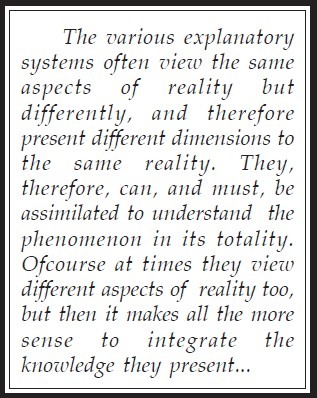
Integrative Therapeutic Approaches
The psychiatrist's knowledge should allow him to think about patients from the dual perspective of both biology and psychology in all clinical encounters (Gabbard and Kay, 2001). Earlier there was concern whether medication and psychotherapy were compatible. This concern is found misplaced today as the common clinical observation is that medication often enhances the patient's reflective capacities (Gabbard, 2003). Integrative approach to therapy works better than dogmatic adherence to therapeutic modalities of one school. Numerous studies prove the contention that a combination of medication and psychotherapy produces better results than either modality alone. Walsh et al (1997), showed that those who receive cognitive behaviour therapy along with antidepressants experience greater reduction in binge eating and depressive symptoms than those receiving only one modality. Hogarty et al (1991) and Zhang et al (1994) showed a combination of psychoeducational family therapy and antipsychotic medication provides dramatic improvements in relapse rates, compared with either treatment alone. Keller et al (2000) demonstrate the advantage of combined treatment in chronic forms of depression. Similarly, Reynolds et al (1999) showed that combined treatment was better for elderly depressives. Barlow et al (2000) showed that the contribution of cognitive behavioural therapy and imipramine (the classic tricyclic, of all drugs: just goes to prove that the old is indeed gold), for the treatment of panic attacks shows clear advantages at long term follow-up over either treatment. Earlier, Mavissakalian (1993) had shown similarly, that behaviour therapy and imipramine has superior efficacy compared to either approach alone in specific phobias and social phobia.
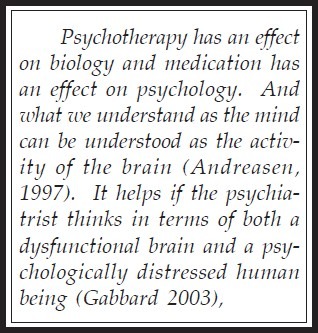
There is a dichotomy in thinking that psychotherapy is a treatment for psychologically based disorders whereas medication should be used for ‘brain-based disorders (Gabbard, 2003). This polarisation is increasingly specious because psychotherapy works by its impact on the brain just as psychopharmacological agents do. Kandel (1998, 1999) shows how psychotherapy works at the synaptic intracellular levels. Psychotherapy is also an example of how environmental experience can alter gene expression (Kandel, 1999). Psychotherapy has an effect on biology and medication has an effect on psychology. And what we understand as the mind can be understood as the activity of the brain (Andreasen, 1997). It helps if the psychiatrist thinks in terms of both a dysfunctional brain and a psychologically distressed human being (Gabbard 2003), what has been termed bimodal relatedness by Docherty et al (1997). Just as a physicist simultaneously thinks in terms of particles and waves,’ the psychiatrist must be capable of shifting from a more or less objective and observational approach to a empathic, intersubjective (but no less scientific) approach. This balancing act is challenging and is the essence of good medical and psychiatric practice and epitomizes Engel's biopsychosocial model. The psychiatrist, like any good physician, treats the whole person’ (Gabbard, 2003).
In this connection the remark on psychiatrists turning more psychopharmacologists and less psychotherapists at the beginning of the paper merits reiteration. And the important comment of Andreasen in this connection must can be recounted here :
Many of us are being pressured to see ourselves as psychopharmacologists who prescribe medication to treat “brain dieases”, at the expense of forgetting that the mind and the person may need treatment with psychotherapy as well. Many of us feel overwhelmed by the pace at which the neuroscientific basis of psychiatry is growing, and threatened by the possibility that we cannot keep up or learn enough to practice well. The technicalities of dopamine receptors, lod scores, in situ hybridization, thalamic nuclei and signal transduction seem both irrelevant to the individual person whom we treat and also beyond our purview or intellectual grasp (Andreasen, 2001).
To which we may add that instability of scientific hypotheses in an inbuilt feature of scientific advancement, which we realise when we see how the most recent of scientific research become outdated tomorrow (Singh and Singh, 2004c, p63). So it makes sense to accept the new, but only provisionally. Because sticking to the old and discarding the new in spite of evidence to the contrary can be as reactionary as believing in the new and rejecting the old to appear modern. Or being coerced into accepting it because of impressive portrayals by ‘specialists’ presented by pharmaceutical companies at five star seminars (Singh and Singh, 2004d, p48).
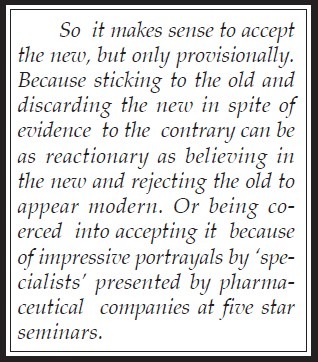
Some More Integrative Efforts
Let us recount here some more attempts already made in this direction. Woody (1971), and Feather and Rhoades (1972), for example, attempted to integrate behavioural and insight techniques, the latter calling it Psychodynamic Behaviour Therapy. Astor (1973) suggested combination of hypnosis, behaviour modification and psychoanalytic psychotherapy. Kandel (1979) focused on psychotherapy and the single synapse, and the impact of psychiatric thought on neurobiological research; and in 1983 focussed on moving from metapsychology to molecular biology. He opined that ‘the emergence of an empirical neuropsychology of cognition based on cellular neurobiology can produce a renaissance of scientific psychoanalysis. This form of psychological analysis may be founded on theoretical hypotheses that are more robust than those applied previously but that are more testable because they will be closer to experimental enquiry.’ Kandel (1979) also concluded that ‘it is only in so far as our words produce changes in each other's brains that psychotherapeutic intervention produces changes in patient's minds. From this perspective, the biological and psychological approaches are joined.’ In further work, Kandel (1993) has delineated the mechanics of learning at the synaptic level which he calls long-term potentiation (LTP). LTP is based on release of second messenger cascade of three distinct kinases triggered by an influx of calcium into the postsynaptic cell, which activates nitric oxide synthetase, which facilitates release of nitric oxide, which then diffuses into the presynaptic terminals and enhances neurotransmitter release. What is important is that extrapolating from this research at the cellular level, Kandel suggests that a similar mechanism must be involved in psychotherapeutic change. He suggests that the phenomenon of LTP supports Freud's notion that early experiences are critical to the development of representations of one's self and body. The dynamic plasticity and malleability of self representations and object representations are paralleled by the strong evidences from Kandel's work that the brain is a dynamic structure that is capable of being modified by experience (Gabbard, 1999).
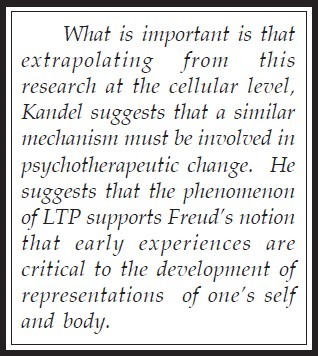
The Future of Freudian Thought
A number of such promising integrative efforts in the field of psychology are being forwarded by genuinely concerned researchers. For example, Omer has been concerned with resolving the conflicts within the various psychotherapeutic schools themselves by the integration of specific and nonspecific measures in psychotherapy (Omer, 1989). Similarly Cooper (1985) has been concerned with the influence of neurobiology on psychoanalysis. He suggests that neurobiology can help us understand which psychoanalytical concepts are unlikely and which congruent with biologic experimentation : ‘Psychoanalytic knowledge of unconscious processes poses interesting problems for the biologists and provides important hints for experimental work. The flow goes both ways …. I think Freud would have been pleased by this prospect’ (Cooper, 1985). In fact Freud believed that psychoanalytic understanding would ultimately be wedded to breakthroughs in the study of brain mechanisms (Gabbard, 2004). Not only this Freud went so far as to acknowledge that our ideas in psychology were provisional and would be based on an organic substructure one day :
… we must recollect that all our provisional ideas in psychology will presumably some day be based on an organic substructure (Freud, 1987).
He was very well aware of the deficiencies of psychological descriptions in his times, even those given by himself, and felt a biological replacement would be appropriate. In fact he prophesied that such answers would blow away the whole artificial structure of hypotheses :
The deficiencies in our description would probably vanish if we were already in a position to replace the psychological terms by physiological or chemical ones… Biology is truly a land of unlimited possibilities. We may expect it to give us the most surprising information and we cannot guess what answers it will return in a few dozen years to the questions we have put to it. They may be of a kind which will blow away the whole of our artificial structure of hypotheses (Freud, 1987).
So, there, the visionary speaks. While he went about making his whole superstructure of psychoanalysis, he was well aware it needed a foundation in biological correlates. Something the contemporary psychoanalytical community may well ponder over, and direct energies towards. If we do not want the ‘artificial’ structure of psychology (and psychoanalysis) to blow away, Kandel (1998) suggests the integration of cognitive neurosciences with scientific psychoanalysis :
The recent merger of cognitive psychology with neural sciences - the discipline we now call cognitive neuroscience - is proving to be one of the most exciting areas in all of biology. What is the aspiration of psychoanalysis if not to be the most cognitive of all neural sciences? The future of psychoanalysis, if it is to have a future, is in the context of an empirical psychology, abetted by imaging techniques, neuroanatomical methods, and human genetics. Embedded in the sciences of human cognition, the ideas of psychoanalysis can be tested and it is here that these ideas can have their greatest impact (Kandel, 1998).
He says in another paper that psychoanalysis must reenergize itself, and that is by developing a closer relationship with biology in general and cognitive neuroscience in particular (Kandel, 1999). He says further:
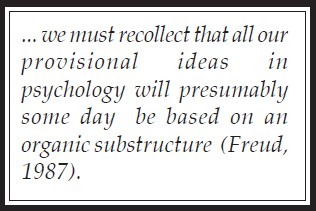
“ It is my hope that by joining with cognitive neuroscience in developing new and compelling perspectives on the mind and its disorders, psychoanalysis will regain its compelling energy ( Kandel, 1999).
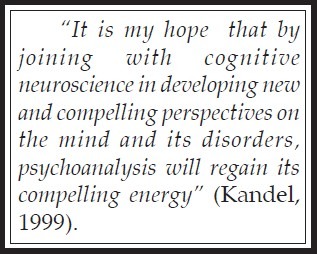
In fact he outlines eight areas in which biology could join with psychoanalysis to make important contributions:
1) the nature of unconscious mental processes, 2) the nature of psychological causality, 3) psychological causality and psychopathology, 4) early experience and the predisposition to mental illness, 5) the preconscious, the unconscious, and the prefrontal cortex, 6) sexual orientation, 7) psychotherapy and structural changes in the brain, and 8) psychopharmacology as an adjunct to psychoanalysis (Kandel, 1999).
His hope for the future is a unified discipline of neurobiology, cognitive psychology and psychoanalysis, and we could not agree less:
One would hope that the excitement and success of current biology would rekindle the investigative curiosities of the psychoanalytic community and that a unified discipline of neurobiology, cognitive psychology and psychoanalysis would forge a new and deeper understanding of mind (Kandel, 1999).
However let us also be warned that the agendas of psychoanalysis, cognitive psychology, and neural science overlap, but they are by no means identical. The three disciplines have different perspectives and aims and could only converge on certain critical issues (Kandel, 1999). A fitting Nobel Laureate, if ever there was one.
Particles and Waves, Motives and Genes
Which brings us to the realisation that it is wonderful to carry out integrative efforts but the danger also remains that the great mass of data so forthcoming may be impossible to categorize and methodically chart out. Thus, rather than the sum being equal to more than the parts, the sum itself may become nonexistent; or disintegrate, and the individual parts may lose their internal cohesiveness. The differences between schools may be resolved by their gradual convergence, by one of the competitors losing its dynamism, or sometimes quite abruptly, as when biometrical genetics and Mendelism were suddenly seen to be complementary instead of being rivals (Slater, 1973). ‘We (must) continue to walk a tight rope between the twin pitfalls of biological and psychological reductionism’ (Gabbard, 1999; parenthesis added), in the distinct hope that they too will be understood as complementary rather than contrary approaches in the not too distant future. But at the same time, we must note that mental states are not easily reducible to neural states. Moreover, the language of psychology and the language of biology involve two different levels of discourse with the patient (Edulson, 1984, Reiser 1985), atleast at present.
The effort to integrate diverse approaches requires a highly synthetic and integrative capacity. The conceptual dilemma for the psychiatrist as succinctly summarised by Slavney (1993), is that the mind and brain can neither by fully integrated nor completely separated. The following approach may help:
Just as the physicist must simultaneously think in terms of particles and waves, the psychiatrist must speak of motives, wishes, and meanings in the same breath as genes, neurochemistry and pharmacokinetics (Gabbard, 1999, p22).
It is hence understandable why few have attempted in this field. Not the least reason can be that it is highly complex and, in the ultimate analysis, may turn out to be unrewarding, being criticized by the very schools it tries to integrate. However, a robust beginning can be made if first of all we realize that methods and designs are only processes in search of hypotheses and theories. And theories in most cases are not intended to be facts but to be explanations of what are considered factual observations by one or more observers at a particular point in investigation. They all have a limited, and hopefully, specific purpose which they serve by helping the investigator significantly rearrange perspectives and promote knowledge and further research.
Also, as at present, in psychiatry we have no method or reasons to systematically and honestly uphold one method and reject the other, aside from personal choice. We say so inspite of the fact that the paradigm shift appears to have tilted firmly towards the biological at present. Indeed:
‘…our interests have shifted toward the biological and away from the individual. Psychiatrists often rely more on fluoxetine (Prozac) than the spoken word. We have seen that a similar shift occurred in the 19th century….our enthrallment with biology has begun to put human individuals, our one-at-a time psychiatric patients, on the back-burner. It should not surprise us, then, that in the current century, alongside the breathtaking strides of biological psychiatry - for they will continue - a new Ideler or Freud will emerge, redirecting our attention to the individual and to some kind of verbal psychotherapy keyed to the needs and suffering of 21st century men and women (Stone, 2003, p 202, 210).
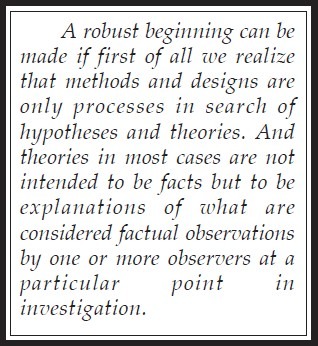
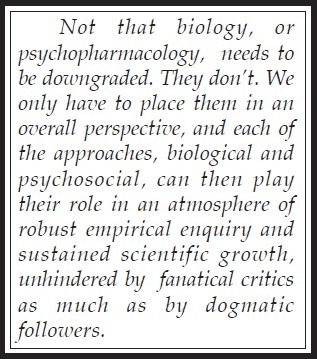
Moreover as Fulford (1999) has argued, psychiatry needs to operate in both the world of facts, as represented by science, and the world of values, as represented by the humanities. To remain in only one world impoverishes medical practice. And what he says of psychiatry can be applied with benefit to the whole of medicine. Similarly Eisenberg (2000) in his discussion of the tendency of psychiatry to be either mindless or brainless, has argued that a balanced approach should be adopted. Like many others, he concludes that the great challenge for the future is to integrate the neurobiological with the social and the psychological. And Andreasen (2001), writing on why did we become psychiatrists makes her point about resisting dehumanization and psychiatrists becoming only psychopharmacologists pretty vehemently :
Each of us, in whatever way we can, must fight against a variety of perverse ideas that denigrate or diminish this unique contribution (of psychiatry to medicine): that a history can be obtained by a computerised check-list, or that recording a narrative history is a waste of time, or that the practice of psychiatry should be limited to prescribing medication, or any of the other injunctions that threaten to dehumanize or destroy the essence of psychiatric practice (Andreasen, 2001; parenthesis added).
It is only a comprehensive outlook and an eclectic approach that can prevent dehumanization and retain psychiatry's unique contribution to medicine, and science. Not that biology, or psychopharmacology, needs to be downgraded. They don’t. We only have to place them in an overall perspective, and each of the approaches, biological and psychosocial, can then play their role in an atmosphere of robust empirical enquiry and sustained scientific growth, unhindered by fanatical critics as much as by dogmatic followers.
Concluding Remarks
Hence we may conclude that till such time that a polarization or integration, whichever, occurs, it behoves the loosely integrated branch that psychiatry at present is to stifle none and foster all approaches in a healthy camaraderie and competition for loyalties. Even if that may be the best course to follow, the greatest promise in the future is for cognitive neurosciences to give greater biological proofs, for the psychological and psychoanalytical to offer insights into phenomena which translate into heuristic and algorithmic models for biology, and for the social and clinical to utilise the finding of both for the welfare of patients in particular and mankind in general.
That is the challenge, and promise, for psychiatry in the future.

The time for confrontation is past. The time for cooperation is here. The moot point is whether the practitioners of this exciting branch will rise to the occasion and actualise the vision of its founders. For in so doing, they may help actualise a trend that medicine as a branch needs to set for itself. And thus prove Engel right when he thought of the biopsychosocial model not only for psychiatry but the whole of medicine (Engel, 1982).
That is the bigger challenge. And that the greater opportunity.
Questions that this Monographs Raises
-
Q. 1
Is eclecticism only a cover to avoid taking a stand for or against a certain school of thought?
-
Q. 2
What is the future of psychoanalysis as a scientific discipline?
-
Q. 3
If we cannot find the necessary methods to prove psychoanalysis or other psychologically oriented therapies right, is it allright to reject them?
-
Q. 4
What sort of integration in psychiatry is likely to forward robust enquiry in individual disciplines and also help achieve a consensus between them?
-
Q. 5
When should the boundaries between schools merge, and where remain strong?
-
Q. 6
What can biological psychiatry give psychoanalysis, and vice versa?
-
Q. 7
Will Freudian thought ever become relevant again?
-
Q. 8
Will neurobiology replace every other understanding in psychiatry eventually?
-
Q. 9
Will psychiatry die and be replaced by clinical psychology which studies behaviour, and neurobiology which studies brain function, and dysfunction?
-
Q. 10
In a holistic understanding, do we smoothen out the wrinkles artificially? Do we gloss over individual differences which are fundamental and at the core of the respective disciplines?
-
Q. 11
Cooperation or confrontation? Polarisation or consensus? Is it an individual or a collective decision? Or both?
-
Q. 12
Freudian thought will always remain controversial and easy to reject. Will that not amount to being intellectually dishonest?
-
Q. 13
The whole trend of rejecting inconvenient approaches and understanding and forwarding one's own preferred method in the name of science and verification is not new. It has happened in philosophy when the logical positivists rejected all metaphysical arguments in the name of the verification principle (and they were mostly scientists, mathematicians etc). Will we allow this to also happen in medicine in general and psychiatry in particular?
-
Q. 14
In there another way of looking at this problem?
Footnotes
Eclecticism : In psychiatry, the selection of compatible features from diverse (and, often, superficially incompatible) systems of metapsychology in an attemp to combine whatever is valid in any theory or doctrine into an integrated harmonious whole (Campbell, 2004).
Some attempts in the Indian context made by the present authors are : (i) in politics, at an analysis of dissidence (1988a, 1988b), and the psychology of mass uproars (1989b; 1989c); (ii) in psycho-history (1989a); and (iii) women's issues e.g. Sati (1989d). The Mens Sana Monographs can also be considered to voice such concerns (Singh and Singh 2004a).
References
- 1.Altshul V.A. The So-Called Boring Patient. American Journal of Psychotherapy. 1977;31:533–545. doi: 10.1176/appi.psychotherapy.1977.31.4.533. [DOI] [PubMed] [Google Scholar]
- 2.Andreasen N. C. Linking mind and brain in the study of illness: a project for a scientific psychopathology. Science. 1997;275:1586–1593. doi: 10.1126/science.275.5306.1586. [DOI] [PubMed] [Google Scholar]
- 3.Andreasen N.C. Diversity in Psychiatry: Or, Why Did We Become Psychiatrists? American Journal of Psychiatry. 2001;158(5):673–675. doi: 10.1176/appi.ajp.158.5.673. [DOI] [PubMed] [Google Scholar]
- 4.Astor M.H. Hypnosis and Behaviour Modification combined with Psychoanalytic Psychotherapy. International Journal of Clinical and Experimental Hypnosis. 1973;21:18–24. doi: 10.1080/00207147308409301. [DOI] [PubMed] [Google Scholar]
- 5.Barlow D.H, Gorman J.M, Shear M.K, et al. Cognitive - behavioral therapy, imipramine, or their combination for panic disorder : a randomized controlled trial. JAMA. 2000;283:2529–2536. doi: 10.1001/jama.283.19.2529. [DOI] [PubMed] [Google Scholar]
- 6.Beutler L.E. Eclectic Psychotherapy: A Systematic approach. 1983 N.Y. Pergamon. [Google Scholar]
- 7.Beveridge A. Time to abandon the subjective - objective divide? Psychiatric Bulletin. 2002;26:101–103. [Google Scholar]
- 8.Brendel D.H. Reductionism, Eclecticism and Pragmatism in Psychiatry. The Dialectic of Clinical Explanation. Jr. Med. Phil. 2003;28(5-6):563–580. doi: 10.1076/jmep.28.5.563.18814. [DOI] [PubMed] [Google Scholar]
- 9.Brown B.S. The Interface between Psychiatry and Politics. In: Freedman A.M, Kaplan H.I, Sadock B.J, editors. In : Comprehensive Textbook of Psychiatry. IInd Edition. Baltimore: Williams and Wilkins; 1975. pp. 2474–2479. Reprinted 1976. [Google Scholar]
- 10.Campbell R.J. Campbell's Psychiatric Dictionary. VIII Edn. N. Y: Ox. Uni.Press; 2004. [Google Scholar]
- 11.Cancro R. Foreword. In: Kalpan H.I, Sadock B.J, editors. In : Comprehensive Textbook of Psychiatry. 4th ED. Baltimore: Williams & Wilkins; 1985. pp. vii–viii. [Google Scholar]
- 12.Caplan G. Principles of Preventive Psychiatry. New York: Basic Books; 1964. [Google Scholar]
- 13.Caplan G. Community Psychiatry. Introduction and Overview. In: Goldstone S.E, editor. In : Concepts of Community Psychiatry : a framework for training. Washington DC: Government Printing Office; 1965. pp. 3–18. [Google Scholar]
- 14.Carstairs G.M. Revolutions and the Rights of Man. American Journal of Psychiatry. 1977;134(9):979–983. doi: 10.1176/ajp.134.9.979. [DOI] [PubMed] [Google Scholar]
- 15.Charlton B. A critique of biological psychiatry. Psychological Medicine. 1990;20:3–6. doi: 10.1017/s0033291700013179. [DOI] [PubMed] [Google Scholar]
- 16.Chodoff P. The Responsibilities of Psychiatrists to Society. In: Hofling Charles K., editor. In : Law and Ethics in the Practice of Psychiatry. New York: Brunner/ Mazel; 1981. pp. 225–238. [Google Scholar]
- 17.Cooper A.M. Will Neurobiology influence Psychoanalysis? American Journal of Psychiatry. 1985;142:1395–1402. doi: 10.1176/ajp.142.12.1395. [DOI] [PubMed] [Google Scholar]
- 18.Docherty J.P, Marder S.R, van Kammen D.P, et al. Psychotherapy and pharmacotherapy: conceptual issues. American Journal of Psychiatry. 1997;134:529–533. doi: 10.1176/ajp.134.5.529. [DOI] [PubMed] [Google Scholar]
- 19.Duhl L.J. The urban condition : people and policy in the metropolis (ed.) New York: Basic Books; 1963. p. 73. [Google Scholar]
- 20.Edelson M. Hypothesis and Evidence in Psychoanalysis. Chicago, Ill: Uni. of Chicago Press; 1984. [Google Scholar]
- 21.Eisenberg L. Is psychiatry more mindful or brainier than what it was a decade ago? British Journal of Psychiatry. 2000;176:1–5. doi: 10.1192/bjp.176.1.1. [DOI] [PubMed] [Google Scholar]
- 22.Engel G. The Need for a New Medical Model : A Challenge for Biomedicine. Science. 1977;196:129–136. doi: 10.1126/science.847460. [DOI] [PubMed] [Google Scholar]
- 23.Engel G.L. Sounding board: the biopsychosocial model and medical education. Who are to be the teachers? New England Journal of Medicine. 1982;306:802–805. doi: 10.1056/NEJM198204013061311. [DOI] [PubMed] [Google Scholar]
- 24.Faumann M.A. In: Study Guide to DSM-IV. 1st Indian Ed. New Delhi: Am. Psy. Press, Jaypee Bros; 1996. Introduction to DSM -IV; p. 1. [Google Scholar]
- 25.Feather B.W, Rhoads J.M. Psychodynamic Behaviour Therapy. Archives of General Psychiatry. 1972;26:496–511. doi: 10.1001/archpsyc.1972.01750240008002. [DOI] [PubMed] [Google Scholar]
- 26.Freud S. On Narcissism : An Introduction. In: On Metapsychology. The Theory Of Psychoanalysis. (Trans. from the German under the gen. ed. of James Stratchey; this vol. comp. edit. by Angela Richards), Penguin Books, Harmondsworth, 1st published in Pelican Books, 1984, Rep. 1987, p67 - 97, this quote on p 71. [Google Scholar]
- 27.Freud S. Beyond the pleasure principle. In: On Metapsychology. The Theory Of Psychoanalysis. (Trans. from the German under the gen. ed. of James Stratchey; this vol. comp. edit. by Angela Richards), Penguin Books, Harmondsworth, 1st published in Pelican Books, 1984, Rep. 1987, p275 339, this quote on p 334. [Google Scholar]
- 28.Fulford V. Analytic philosophy, brain science and the concept of disorders. In: Bloch S, Chodoff P, Green S, editors. In: Psychiatric Ethics. Ox.Uni.Press; 1999. pp. 161–192. [Google Scholar]
- 29.Fuller Torrey E. Bleak at best: What is the Future of Psychiatry as a Medical Speciality. In: Brady John Paul, Keith H, Brodie H., editors. Controversy in Psychiatry. Phila: Saunders; 1978. pp. 3–12. [Google Scholar]
- 30.Gabbard G.O. Mind and Brain in Psychiatric Treatment. In: Gabbard Glen O., editor. Treatments of Psychiatric Disorders. II Edn. Vol. 1. New Delhi: Jaypee Bros; 1999. pp. 22–34. Ind.Ed. [Google Scholar]
- 31.Gabbard G.O, Kay J. The fate of integrated movement: whatever happened to the biopsychosocial model? American Journal of Psychiatry. 2001;158:1956–1963. doi: 10.1176/appi.ajp.158.12.1956. [DOI] [PubMed] [Google Scholar]
- 32.Gabbard G.O. Introduction. In: Hales Robert E, Yudofsky Stuart C., editors. The American Psychiatric Publishing Textbook of Clinical Psychiatry. Bangalore: Am. Psy. Pub., Wash., Panther Pub; 2003. pp. xxi–xxiii. (Reprint 2003) [Google Scholar]
- 33.Gabbard G.O. Images in Psychiatry: Sigmund Freud (1859-1939) American Journal of Psychiatry. 2004;161:232. doi: 10.1176/appi.ajp.161.2.232. [DOI] [PubMed] [Google Scholar]
- 34.Ghaemi N.S. The Concepts of Psychiatry : A Pluralistic Approach to the Mind and Mental Illness. Baltimore: John Hopkins Uni.Press; 2003. [Google Scholar]
- 35.Community Psychiatry, a Reappraisal, Publication 113. New York: Mental Health Materials Center; 1983. Group for the Advancement of Psychiatry. [Google Scholar]
- 36.Havens L.B. Approaches to the Mind. Boston: Little Brown; 1973. [Google Scholar]
- 37.Hogarty G.E, Anderson C.M, Reiss D.J, et al. Family psychoeducation, social skills training and maintenance chemotherapy in the after care treatment of schizophrenia, II: two year effects of a controlled study on relapse and adjustment. Archives of General Psychiatry. 1991;48:340–347. doi: 10.1001/archpsyc.1991.01810280056008. [DOI] [PubMed] [Google Scholar]
- 38.Hudson R.P. Death, Dying and the Zealous Phase. Annals of Internal Medicine. 1978;88:696–702. doi: 10.7326/0003-4819-88-5-696. [DOI] [PubMed] [Google Scholar]
- 39.Ibor J.J.I. Opening Speech of J.J. Lopez Ibor, President of the World Psychiatric Association. In: de la Fuente Ramon, Weisman Maxwell N., editors. In : Psychiatry : Proceedings of the V World Congress of Psychiatry, Mexico, D.F., 25 Nov. -4 Dec, 1971, Part I. Amsterdam: Excerpta Medica; 1973. p. XXV. [Google Scholar]
- 40.IGDA WORKGROUP, WPA. IGDA. Introduction. British Journal of Psychiatry. 2003a;182(Supp. 45):s37–39. [PubMed] [Google Scholar]
- 41.IGDA WORKGROUP, WPA. Conceptual Basis - historical, cultural and clinical perspective. British Journal of Psychiatry. 2003b;182:s40–41. [PubMed] [Google Scholar]
- 42.Kendler K.S. Empiricism and Eclecticism in Psychiatry. American Journal of Psychiatry. 1978;135(1):131–132. [PubMed] [Google Scholar]
- 43.Kandel E.R. Psychotherapy and the single synapse : the impact of psychiatric thought on neurobiologic research. New England Journal of Medicine. 1979;301:1028–1037. doi: 10.1056/NEJM197911083011904. [DOI] [PubMed] [Google Scholar]
- 44.Kandel E.R. From metapsychology to molecular biology : explorations into the nature of anxiety. American Journal of Psychiatry. 1983;140:1277–1293. doi: 10.1176/ajp.140.10.1277. [DOI] [PubMed] [Google Scholar]
- 45.Kandel E.R. San Francisco, C.A: 1993. May, Genes, synapses and declarative forms of memory, Lecture given at the 146th Annual Meeting of the American Psychiatric Association. 1993. [Google Scholar]
- 46.Kandel E.R. A new intellectual framework of Psychiatry. American Journal of Psychiatry. 1998;155:457–469. doi: 10.1176/ajp.155.4.457. [DOI] [PubMed] [Google Scholar]
- 47.Kandel E.R. Biology and the future of psychoanalysis: a new intellectual framework for psychiatry revisited. American Journal of Psychiatry. 1999;156:505–524. doi: 10.1176/ajp.156.4.505. [DOI] [PubMed] [Google Scholar]
- 48.Keller M. G, McCullogh J.P, Klein D. N, et al. A comparison of nefazodone, the cognitive behavioral analysis system of psychotherapy, and their combination for the treatment of chronic depression. N. Eng. Jr. Med. 2000;342:1462–1470. doi: 10.1056/NEJM200005183422001. [DOI] [PubMed] [Google Scholar]
- 49.Klerman G.L. Introduction. In: Griest J.H, Jefferson J.W, Spitzer R.L, editors. In : Treatment of Mental Disorders. New York, Oxford: 1982. pp. xvii–xxviii. [Google Scholar]
- 50.Kolb L.C, Brodie H.K.H. In : Modern Clinical Psychiatry. Philadelphia: Saunders; 1982. The Beginnings of Psychiatry; p. 2. [Google Scholar]
- 51.Kubie L. The Retreat from Patients. Archives of General Psychiatry. 1971;24 doi: 10.1001/archpsyc.1971.01750080002002. [DOI] [PubMed] [Google Scholar]
- 52.Lazarus A.A. In support of Technical Eclecticism. Psychology Reporter. 1967;21(99):415–416. doi: 10.2466/pr0.1967.21.2.415. [DOI] [PubMed] [Google Scholar]
- 53.Luhrmann T.M. In: Of Two minds: The Growing Disorder in American Psychiatry. Knopf Alfred A., editor. New York: 2000. [Google Scholar]
- 54.Mavissakalian M.R. Combined behaviour and pharmacological treatment of anxiety disorders. In: Oldham J.M, Riba M.B, editors. The American Psychiatric Press Review of Psychiatry. Vol. 12. Wash. D.C: Am. Psy. Press; 1993. pp. 565–584. [Google Scholar]
- 55.Mechanic D. The social dimension. In: Sidney Bloch, Chodoff Paul., editors. In : Psychiatric Ethics. Oxford University Press; 1984. pp. 46–60. [Google Scholar]
- 56.Michels R. The Responsibility of Psychiatry to Society. In: Hofling Charles K., editor. In : Law and Ethics in the Practice of Psychiatry. New York: Brunner/ Mazel; 1981. pp. 239–251. [Google Scholar]
- 57.Millon T. In : Theories of Psychopathology and Personality : Essays and Critiques. II Edition. Philadelphia: Sauners; 1973. Introduction. [Google Scholar]
- 58.Omer H. Specifics and Non-specifics in Psychotherapy. American Journal of Psychotherapy. 1989;XLIII(2):181–192. doi: 10.1176/appi.psychotherapy.1989.43.2.181. [DOI] [PubMed] [Google Scholar]
- 59.Patterson C.H. In: Understanding Psychotherapy: Fifty Years of Client-Centered theory and Practice. Vol. 26. PCCS Books; 1989. Eclecticism in Psychotherapy: Is Integration Possible?, Psychotherapy, 1989; pp. 157–161. 2000. [Google Scholar]
- 60.Polkinghorne D. Methodology for the Human Sciences. N.Y: State Uni. of N. Y. Press; 1983. [Google Scholar]
- 61.Reiser M.F. Converging sectors of psychoanalysis and neurobiology : mutual challenge and opportunity. Journal of American Psychoanalytic Assoc. 1985;33:11–34. doi: 10.1177/000306518503300102. [DOI] [PubMed] [Google Scholar]
- 62.Reynolds C.F, Frank E, Perel J.M, et al. Nortriptyline and interpersonal psychotherapy as maintenance therapies for recurrent major depression: a randomised controlled trial in patients older than 59 years. JAMA. 1999;281:39–45. doi: 10.1001/jama.281.1.39. [DOI] [PubMed] [Google Scholar]
- 63.Sadock B.J, Sadock V.A. Preface. In: Sadock B.J, Sadock V.A, editors. Kaplan and Sadock Synopsis of Psychiatry. Phila: Lipp Will and Wilkins; 2003. p. vii. [Google Scholar]
- 64.Sartorius N. In : The ICD-10 Classification of Mental and Behavioral Sciences. Clinical descriptions and diagnostic guidelines. WHO, Geneva, IInd Impression, Ox.Uni.Press: Delhi; 1993. Preface; p. vi. [Google Scholar]
- 65.Saunders J. The practice of clinical medicine as an art and as a science. Medical Humanities. 2000;26:18–22. doi: 10.1136/mh.26.1.18. [DOI] [PubMed] [Google Scholar]
- 66.Scherl D.J, Macht L.B. Deinstitutionalization in the absence of consensus. Hospital and Community Psychiatry. 1979;30:599–601. doi: 10.1176/ps.30.9.599. [DOI] [PubMed] [Google Scholar]
- 67.Simon R.M. On Eclecticism. American Journal of Psychiatry. 1974;131:135–139. doi: 10.1176/ajp.131.2.135. [DOI] [PubMed] [Google Scholar]
- 68.Singh A.R, Singh S.A. Some Issues in Psychotherapy. The Indian Practitioner. 1985;38(12):1193–1201. [Google Scholar]
- 69.Singh A.R, Singh S.A. Readings in Dissent. New Quest. 1988a;71:289–296. [Google Scholar]
- 70.Singh A.R, Singh S.A. Readings in Dissent. New Quest. 1988b;72:333–347. [Google Scholar]
- 71.Singh A, Singh S. Psyche of Zail Singh : Patterns in Mosaic. Psychology and Human Behaviour Digest. 1989a;1(1):25–27. 11-13. [Google Scholar]
- 72.Singh A, Singh S. Bofors and other exposes : Where are we and where do we go from here? (46).Psychology and Human Behaviour Digest. 1989b;1(3):9–14. [Google Scholar]
- 73.Singh A, Singh S. Assassinations, Backlashes and Messiahs. Psychology and Human Behaviour Digest. 1989c;1(4 and 5):6–13. [Google Scholar]
- 74.Singh A, Singh S. The Psychology of Sati. Psychology and Human Behaviour Digest. 1989d;1(4 and 5):47–51. [Google Scholar]
- 75.Singh A.R, Singh S.A. Singh A.R, Singh S.A, editors. Conceptual foundation of Mens Sana Monographs. Psychiatry, Science, Religion and Health, MSM Annual 2004. 2004a;II(1-3):xxi–xxiv. [PMC free article] [PubMed] [Google Scholar]
- 76.Singh A.R, Singh S.A. Preface to the First Monograph: The Fourth Psychiatric Revolution. In: Singh A.R, Signh S.A, editors. Psychiatry, Science, Religion and Health, MSM Annual 2004. 1-3. II. 2004b. pp. 3–3. [Google Scholar]
- 77.Singh A.R, Singh S.A. Singh A.R, Signh S.A, editors. Replicative Nature of Indian Research, Essence of Scientific Temper and Future of scientific progress. Psychiatry, Science, Religion and Health, MSM Annual 2004. 2004c;II(1-3):57–69. [PMC free article] [PubMed] [Google Scholar]
- 78.Singh A.R, Singh S.A. Singh A.R, Signh S.A, editors. What shall we do about our concern with the most recent in psychiatric research. Psychiatry, Science, Religion and Health, MSM Annual 2004. 2004d;II(1-3):45–50. [Google Scholar]
- 79.Slater E. The Psychiatrist In Search of a Science : II. Developments in the Logic and the Sociology of Science. British Journal of Psychiatry. 1973;122:625–636. doi: 10.1192/bjp.122.6.625. [DOI] [PubMed] [Google Scholar]
- 80.Slater E, Roth M. In : Mayer-Gross Slater and Roth Clinical Psychiatry. III Edition. London: Bailliere Tindall; 1986. The field of psychiatry; pp. 6–10. [Google Scholar]
- 81.Slavney P.R. The mind-brain problem, epistemology and psychiatric education. Academic Psychiatry. 1993;17:59–66. doi: 10.1007/BF03341855. [DOI] [PubMed] [Google Scholar]
- 82.Stone M.H. A Brief History of Psychiatry. In: Tasman A, Kay J, Lieberman A, editors. Psychiatry. II Edn. Bangalore: John Wiley and Sons, Sussex and Panther Pub; 2003. pp. 177–210. [Google Scholar]
- 83.Talbot J.A. Deinstitutionalization : avoiding the disastrous past. Hospital and Community Psychiatry. 1979;30:621–624. doi: 10.1176/ps.30.9.621. [DOI] [PubMed] [Google Scholar]
- 84.Talbot J.A. The patient first or last. Hospital and Community Psychiatry. 1984;35:341–344. doi: 10.1176/ps.35.4.341. [DOI] [PubMed] [Google Scholar]
- 85.Talbot J.A. Presidential Address : Our Patients’ Future in a Changing World : The Imperative for Psychiatric Involvement in Public Policy. American Journal of Psychiatry. 1985;142:1003–1008. doi: 10.1176/ajp.142.9.1003. [DOI] [PubMed] [Google Scholar]
- 86.Tasman A, Kay J, Lieberman . Preface to First Edition. In: Tasman A, Kay J, Lieberman J. A, editors. Psychiatry. II Edn. Bangalore: John Wiley and Sons, Sussex and Panther Pub; 2003. p. xvii. [Google Scholar]
- 87.Thorne F.C. An Eclectic evaluation of Psychotherapeutic methods. In: Jurjerich R.M, editor. In : Direct Psychotherapy. II. Miami: Coral Gables; 1973. pp. 847–883. [Google Scholar]
- 88.Trethowan W, Sims A.C.P. In : Psychiatry. Eastbourne: ELBS/Bailliere Tindall; 1983. Introduction; p. 10. [Google Scholar]
- 89.Vaillant G.E. Mental Health. American Journal of Psychiatry. 2003;160:1373–1384. doi: 10.1176/appi.ajp.160.8.1373. [DOI] [PubMed] [Google Scholar]
- 90.Walsh B.T, Wilson G.T, Loeb K.L, et al. Medication and psychotherapy in the treatment of bulimia nervosa. American Journal of Psychiatry. 1997;154:523–531. doi: 10.1176/ajp.154.4.523. [DOI] [PubMed] [Google Scholar]
- 91.Lexicon of Psychiatric and Mental Health Terms. Vol. 1. Geneva: 1989. WHO. [Google Scholar]
- 92.Woody R.H. Psychobehavioural Counselling and Therapy : Integrating Behavioural and Insight Techniques. New York: Appleton-Century-Crofts; 1971. [Google Scholar]
- 93.Zhang M, Wang M, Li J, et al. Randomised controlled trial of family intervention for 78 first-episode male schizophrenic patients: an 18 - month study in Suzhou Jiagsu. British Journal of Psychiatry. 1994;165(Supplement):96–102. [PubMed] [Google Scholar]


